“I’m not the greatest; I’m the double greatest. Not only do I knock ’em out, I pick the round. “
– Muhammad Ali
Short Biography Muhammad Ali
Muhammad Ali (born Cassius Marcellus Clay, Jr. on January 17, 1942) is a

retired American boxer. In 1999, Ali was crowned “Sportsman of the Century” by Sports Illustrated. He won the World Heavyweight Boxing championship three times, and won the North American Boxing Federation championship as well as an Olympic gold medal.
Ali was born in Louisville, Kentucky. He was named after his father, Cassius Marcellus Clay, Sr., (who was named for the 19th century abolitionist and politician Cassius Clay). Ali later changed his name after joining the Nation of Islam and subsequently converted to Sunni Islam in 1975.
Early boxing career
Standing at 6’3″ (1.91 m), Ali had a highly unorthodox style for a heavyweight boxer. Rather than the normal boxing style of carrying the hands high to defend the face, he instead relied on his ability to avoid a punch. In Louisville, October 29, 1960, Cassius Clay won his first professional fight. He won a six-round decision over Tunney Hunsaker, who was the police chief of Fayetteville, West Virginia. From 1960 to 1963, the young fighter amassed a record of 19-0, with 15 knockouts. He defeated such boxers as Tony Esperti, Jim Robinson, Donnie Fleeman, Alonzo Johnson, George Logan, Willi Besmanoff, Lamar Clark (who had won his previous 40 bouts by knockout), Doug Jones, and Henry Cooper. Among Clay’s victories were versus Sonny Banks (who knocked him down during the bout), Alejandro Lavorante, and the aged Archie Moore (a boxing legend who had fought over 200 previous fights, and who had been Clay’s trainer prior to Angelo Dundee).

Clay won a disputed 10 round decision over Doug Jones, who, despite being lighter than Clay, staggered Clay as soon as the fight started with a right hand, and beat Clay to the punch continually during the fight. The fight was named “Fight of the Year” for 1963. Clay’s next fight was against Henry Cooper, who knocked Clay down with a left hook near the end of the fourth round. The fight was stopped in the 5th round due to a deep cut on Cooper’s face.
Despite these close calls against Doug Jones and Henry Cooper, he became the top contender for Sonny Liston’s title. In spite of Clay’s impressive record, he was not expected to beat the champ. The fight was to be held on February 25, 1964 in Miami, Florida. During the weigh-in on the previous day, the ever-bashful Ali—who frequently taunted Liston during the buildup by dubbing him “the big ugly bear”, among other things—declared that he would “float like a butterfly and sting like a bee,” and, in summarizing his strategy for avoiding Liston’s assaults, said, “Your hands can’t hit what your eyes can’t see.”
Vietnam puts a pause in Ali’s career
In 1964, Ali failed the Armed Forces qualifying test because his writing and spelling skills were subpar. However, in early 1966, the tests were revised and Ali was reclassified 1A. He refused to serve in the United States Army during the Vietnam War as a conscientious objector, because “War is against the teachings of the Holy Koran. I’m not trying to dodge the draft. We are not supposed to take part in no wars unless declared by Allah or The Messenger. We don’t take part in Christian wars or wars of any unbelievers.” Ali also famously said,
“I ain’t got no quarrel with those Vietcong” and “no Vietcong ever called me nigger.”
Ali refused to respond to his name being read out as Cassius Clay, stating, as instructed by his mentors from the Nation of Islam, that Clay was the name given to his slave ancestors by the white man.
“Cassius Clay is a slave name. I didn’t choose it and I don’t want it. I am Muhammad Ali, a free name – it means beloved of God – and I insist people use it when people speak to me and of me. “
By refusing to respond to this name, Ali’s personal life was filled with controversy. Ali was essentially banned from fighting in the United States and forced to accept bouts abroad for most of 1966.
From his rematch with Liston in May 1965, to his final defense against Zora Folley in March 1967, he defended his title nine times. Few other heavyweight champions in history have fought so much in such a short period.
Ali was scheduled to fight WBA champion Ernie Terrell in a unification bout in Toronto on March 29, 1966, but Terrell backed out and Ali won a 15-round decision against substitute opponent George Chuvalo. He then went to England and defeated Henry Cooper and Brian London by stoppage on cuts. Ali’s next defense was against German southpaw Karl Mildenberger, the first German to fight for the title since Max Schmeling. In one of the tougher fights of his life, Ali stopped his opponent in round 12.
Ali returned to the United States in November 1966 to fight Cleveland “Big Cat” Williams in the Houston Astrodome. A year and a half before the fight, Williams had been shot in the stomach at point-blank range by a Texas policeman. As a result, Williams went into the fight missing one kidney, 10 feet of his small intestine, and with a shriveled left leg from nerve damage from the bullet. Ali beat Williams in three rounds.
On February 6, 1967, Ali returned to a Houston boxing ring to fight Terrell in what became one of the uglier fights in boxing. Terrell had angered Ali by calling him Clay, and the champion vowed to punish him for this insult. During the fight, Ali kept shouting at his opponent, “What’s my name, Uncle Tom … What’s my name.” Terrell suffered 15 rounds of brutal punishment, losing 13 of 15 rounds on two judges’ scorecards, but Ali did not knock him out. Analysts, including several who spoke to ESPN on the sports channel’s “Ali Rap” special, speculated that the fight only continued because Ali chose not to end it, choosing instead to further punish Terrell. After the fight, Tex Maule wrote, “It was a wonderful demonstration of boxing skill and a barbarous display of cruelty.”
Ali’s actions in refusing military service and aligning himself with the Nation of Islam made him a lightning rod for controversy, turning the outspoken but popular former champion into one of that era’s most recognizable and controversial figures. Appearing at rallies with Nation of Islam leader Elijah Muhammad and declaring his allegiance to him at a time when mainstream America viewed them with suspicion — if not outright hostility — made Ali a target of outrage, and suspicion as well. Ali seemed at times to even provoke such reactions, with viewpoints that wavered from support for civil rights to outright support of separatism.
Near the end of 1967, Ali was stripped of his title by the professional boxing commission and would not be allowed to fight professionally for more than three years. He was also convicted for refusing induction into the army and sentenced to five years in prison. Over the course of those years in exile, Ali fought to appeal his conviction. He stayed in the public spotlight and supported himself by giving speeches primarily at rallies on college campuses that opposed the Vietnam War.
“Why should they ask me to put on a uniform and go 10,000 miles from home and drop bombs and bullets on brown people while so-called Negro people in Louisville are treated like dogs? “
– Muhammad Ali – explaining why he refused to fight in Vietnam
In 1970, Ali was allowed to fight again, and in late 1971 the Supreme Court reversed his conviction.
Muhammad Ali’s comeback
In 1970, Ali was finally able to get a boxing license. With the help of a State Senator, he was granted a license to box in Georgia because it was the only state in America without a boxing commission. In October 1970, he returned to stop Jerry Quarry on a cut after three rounds. Shortly after the Quarry fight, the New York State Supreme Court ruled that Ali was unjustly denied a boxing license. Once again able to fight in New York, he fought Oscar Bonavena at Madison Square Garden in December 1970. After a tough 14 rounds, Ali stopped Bonavena in the 15th, paving the way for a title fight against Joe Frazier.
The Fight of the Century
Ali and Frazier fought each other on March 8, 1971, at Madison Square Garden. The fight, known as ‘”The Fight of the Century”, was one of the most eagerly anticipated bouts of all time and remains one of the most famous. It featured two skilled, undefeated fighters, both of whom had reasonable claims to the heavyweight crown. The fight lived up to the hype, and Frazier punctuated his victory by flooring Ali with a hard left hook in the 15th and final round and won on points. Frank Sinatra — unable to acquire a ringside seat — took photos of the match for Life Magazine. Legendary boxing announcer Don Dunphy and actor and boxing aficionado Burt Lancaster called the action for the broadcast, which reached millions of people.
Frazier eventually won the fight and retained the title with a unanimous decision, dealing Ali his first professional loss. Despite an impressive performance, Ali may have still been suffering from the effects of “ring rust” due to his long layoff.
In 1973, after a string of victories over top Heavyweight opposition in a campaign to force a rematch with Frazier, Ali split two bouts with Ken Norton (in the bout that Ali lost to Norton, Ali suffered a broken jaw).
Rumble in the Jungle
In 1974, Ali gained a match with champion George Foreman. The fight took place in Zaire (the Congo) – Ali wanted the fight to be there to help give an economic boost to this part of Africa. The pre-match hype was as great as ever.
“Floats like a butterfly, sting like a bee, his hands can’t hit what his eyes can’t see.”
– Muhammad Ali – before the 1974 fight against George Foreman
Against the odds, Ali won the rematch in the eighth round. Ali had adopted a strategy of wearing Foreman down though absorbing punches on the ropes – a strategy later termed – rope a dope.
This gave Ali another chance at the world title against Frazer
It will be a killer, and a chiller, and a thriller, when I get the gorilla in Manila.”
– Ali before Frazer fight.
The fight lasted 14 rounds, with Ali finally proving victorious in the testing African heat.
Muhammad Ali in retirement
Ali was diagnosed with Parkinson’s disease in the early 1980s, following which his motor functions began a slow decline. Although Ali’s doctors disagreed during the 1980s and 1990s about whether his symptoms were caused by boxing and whether or not his condition was degenerative, he was ultimately diagnosed with Pugilistic Parkinson’s syndrome. By late 2005 it was reported that Ali’s condition was notably worsening. According to the documentary When We Were Kings, when Ali was asked about whether he has any regrets about boxing due to his disability, he responded that if he didn’t box he would still be a painter in Louisville, Kentucky.
Despite the disability, he remains a beloved and active public figure. Recently he was voted into Forbes Celebrity 100 coming in at number 13 behind Donald Trump. In 1985, he served as a guest referee at the inaugural WrestleMania event. In 1987 he was selected by the California Bicentennial Foundation for the U.S. Constitution to personify the vitality of the U.S. Constitution and Bill of Rights in various high profile activities. Ali rode on a float at the 1988 Tournament of Roses Parade, launching the U.S. Constitution’s 200th birthday commemoration. He also published an oral history, Muhammad Ali: His Life and Times with Thomas Hauser, in 1991. Ali received a Spirit of America Award calling him the most recognized American in the world. In 1996, he had the honor of lighting the flame at the 1996 Summer Olympics in Atlanta, Georgia.
He has appeared at the 1998 AFL Grand Final, where Anthony Pratt recruited him to watch the game. He also greets runners at the start line of the Los Angeles Marathon every year.
In 1999, Ali received a special one-off award from the BBC at its annual BBC Sports Personality of the Year Award ceremony, which was the BBC Sports Personality of the Century Award. His daughter Laila Ali also became a boxer in 1999, despite her father’s earlier comments against female boxing in 1978: “Women are not made to be hit in the breast, and face like that… the body’s not made to be punched right here [patting his chest]. Get hit in the breast… hard… and all that.”
On September 13, 1999, Ali was named “Kentucky Athlete of the Century” by the Kentucky Athletic Hall of Fame in ceremonies at the Galt House East.
In 2001, a biographical film, entitled Ali, was made, with Will Smith starring as Ali. The film received mixed reviews, with the positives generally attributed to the acting, as Smith and supporting actor Jon Voight earned Academy Award nominations. Prior to making the Ali movie, Will Smith had continually rejected the role of Ali until Muhammad Ali personally requested that he accept the role. According to Smith, the first thing Ali said about the subject to Smith was: “You ain’t pretty enough to play me”.
He received the Presidential Medal of Freedom at a White House ceremony on November 9, 2005, and the prestigious “Otto Hahn peace medal in Gold” of the United Nations Association of Germany (DGVN) in Berlin for his work with the US civil rights movement and the United Nations (December 17 2005).
On November 19, 2005 (Ali’s 19th wedding anniversary), the $60 million non-profit Muhammad Ali Center opened in downtown Louisville, Kentucky. In addition to displaying his boxing memorabilia, the center focuses on core themes of peace, social responsibility, respect, and personal growth.
According to the Muhammad Ali Center website, “Since he retired from boxing, Ali has devoted himself to humanitarian endeavors around the globe. He is a devout Sunni Muslim, and travels the world over, lending his name and presence to hunger and poverty relief, supporting education efforts of all kinds, promoting adoption and encouraging people to respect and better understand one another. It is estimated that he has helped to provide more than 22 million meals to feed the hungry. Ali travels, on average, more than 200 days per year.”
At the FedEx Orange Bowl on January 2, 2007, Ali was an honorary captain for the Louisville Cardinals wearing their white jersey, number 19. Ali was accompanied by golf legend Arnold Palmer, who was the honorary captain for the Wake Forest Demon Deacons, and Miami Heat star Dwyane Wade.
A youth club in Ali’s hometown and a species of rose (Rosa ali) have also been named after him.
Muhammad Ali currently lives on a small farm near Berrien Springs, Michigan with his fourth wife, Yolanda ‘Lonnie’ Ali.
 Born in 1879, Ulm Germany, Albert Einstein was to become the most celebrated scientist of the Twentieth Century. His theories were to lay the framework for new branches of physics. He also become well known as a humanitarian, speaking out against nuclear weapons – weapons he had indirectly contributed towards creating.
Born in 1879, Ulm Germany, Albert Einstein was to become the most celebrated scientist of the Twentieth Century. His theories were to lay the framework for new branches of physics. He also become well known as a humanitarian, speaking out against nuclear weapons – weapons he had indirectly contributed towards creating.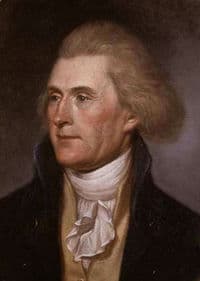 As a young child Thomas Jefferson was an enthusiastic student, often spending up to 15 hours a day studying. He was to retain a life long interest in reading. He had both a keen intellect and also a wide range of interests. His interests ranged from philosophy and architecture to the natural sciences. At the age of 16 he entered the College of William and Mary in Williamsburg, and two years later he graduated with the highest honours. After leaving college he became a lawyer and later served in the Virginian state Burgess. One of his earliest political writings of significance was A Summary View of the Rights of British America (1774). This expressed a thoughtful summary of a way America could make a settlement with Britain. It played an important role in shaping opinions in the lead up to the War of Independence.
As a young child Thomas Jefferson was an enthusiastic student, often spending up to 15 hours a day studying. He was to retain a life long interest in reading. He had both a keen intellect and also a wide range of interests. His interests ranged from philosophy and architecture to the natural sciences. At the age of 16 he entered the College of William and Mary in Williamsburg, and two years later he graduated with the highest honours. After leaving college he became a lawyer and later served in the Virginian state Burgess. One of his earliest political writings of significance was A Summary View of the Rights of British America (1774). This expressed a thoughtful summary of a way America could make a settlement with Britain. It played an important role in shaping opinions in the lead up to the War of Independence.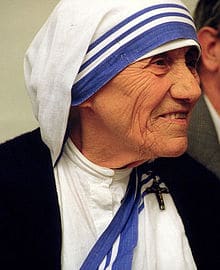 Mother Teresa was born, 1910, in Skopje, capital of the Republic of Macedonia. Little is known about her early life, but at a young age she felt a calling to be a nun and serve through helping the poor. At the age of 18 she was given permission to join a group of nuns in Ireland. After a few months of training, with the Sisters of Loreto, she was then given permission to travel to India. She took her formal religious vows in 1931, and chose to be named after St Therese of Lisieux – the patron saint of missionaries.
Mother Teresa was born, 1910, in Skopje, capital of the Republic of Macedonia. Little is known about her early life, but at a young age she felt a calling to be a nun and serve through helping the poor. At the age of 18 she was given permission to join a group of nuns in Ireland. After a few months of training, with the Sisters of Loreto, she was then given permission to travel to India. She took her formal religious vows in 1931, and chose to be named after St Therese of Lisieux – the patron saint of missionaries.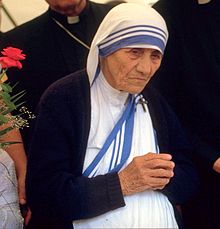 She experienced two particularly traumatic periods in Calcutta. The first was the Bengal famine of 1943 and the second was the Hindu/Muslim violence in 1946 – before the partition of India. In 1948, she left the convent to live full time amongst the poorest of Calcutta. She chose to wear a white Indian Sari, with blue trimmings – out of respect for the traditional Indian dress. For many years, Mother Teresa and a small band of fellow nuns survived on minimal income and food, often having to beg for funds. But, slowly her efforts with the poorest were noted and appreciated by the local community and Indian politicians.
She experienced two particularly traumatic periods in Calcutta. The first was the Bengal famine of 1943 and the second was the Hindu/Muslim violence in 1946 – before the partition of India. In 1948, she left the convent to live full time amongst the poorest of Calcutta. She chose to wear a white Indian Sari, with blue trimmings – out of respect for the traditional Indian dress. For many years, Mother Teresa and a small band of fellow nuns survived on minimal income and food, often having to beg for funds. But, slowly her efforts with the poorest were noted and appreciated by the local community and Indian politicians. In 1979, she was awarded the Nobel Peace Prize “for work undertaken in the struggle to overcome poverty and distress, which also constitutes a threat to peace.” She didn’t attend the ceremonial banquet, but asked that the $192,000 fund be given to the poor.
In 1979, she was awarded the Nobel Peace Prize “for work undertaken in the struggle to overcome poverty and distress, which also constitutes a threat to peace.” She didn’t attend the ceremonial banquet, but asked that the $192,000 fund be given to the poor. Leonardo was born an illegitimate son of a Florentine noble and peasant woman and grew up in Vinci, Italy. In his formative years he developed a love of nature and from an early age displayed his remarkable academic and artistic talents and capacities.
Leonardo was born an illegitimate son of a Florentine noble and peasant woman and grew up in Vinci, Italy. In his formative years he developed a love of nature and from an early age displayed his remarkable academic and artistic talents and capacities.
 Abraham lost his mother and his father moved away to Indiana. Abraham had to work hard splitting logs and other manual labour. But, he also had a thirst for knowledge and worked very hard to excel in his studies. This led him to become trained as a lawyer. He spent eight years working on the Illinois court circuit; his ambition, drive and capacity for hard work were evident to all around him. He also had a good sense of humour and was depreciating about his looks.
Abraham lost his mother and his father moved away to Indiana. Abraham had to work hard splitting logs and other manual labour. But, he also had a thirst for knowledge and worked very hard to excel in his studies. This led him to become trained as a lawyer. He spent eight years working on the Illinois court circuit; his ambition, drive and capacity for hard work were evident to all around him. He also had a good sense of humour and was depreciating about his looks.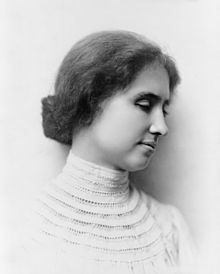 Helen Keller was born 27 June 1880 in Tusculum, Alabama. When she was only 19 months old, she experienced a severe childhood illness, which left her deaf and blind (only a very partial sight). For the first few years of her life, she was only able to communicate with her family through a rudimentary number of signs; she had a little more success communicating with the six year old daughter of the family cook. However, unable to communicate properly, she was considered to be badly behaved, for example, eating from the plates of anyone on the table with her fingers.
Helen Keller was born 27 June 1880 in Tusculum, Alabama. When she was only 19 months old, she experienced a severe childhood illness, which left her deaf and blind (only a very partial sight). For the first few years of her life, she was only able to communicate with her family through a rudimentary number of signs; she had a little more success communicating with the six year old daughter of the family cook. However, unable to communicate properly, she was considered to be badly behaved, for example, eating from the plates of anyone on the table with her fingers.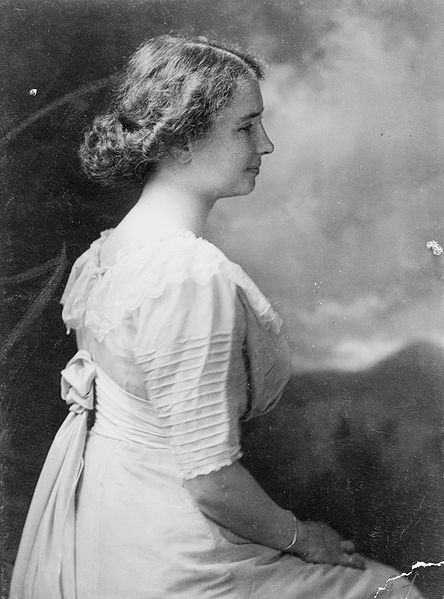 Keller made rapid progress and quickly overcame her bad habits. She became proficient in Braille, and was able to begin a fruitful education, despite her disability. Keller made more progress than anyone expected. She would later learn to write with a Braille typewriter.
Keller made rapid progress and quickly overcame her bad habits. She became proficient in Braille, and was able to begin a fruitful education, despite her disability. Keller made more progress than anyone expected. She would later learn to write with a Braille typewriter.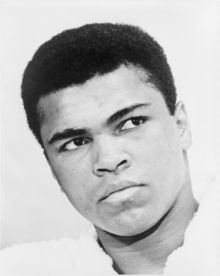 retired American boxer. In 1999, Ali was crowned “Sportsman of the Century” by Sports Illustrated. He won the World Heavyweight Boxing championship three times, and won the North American Boxing Federation championship as well as an Olympic gold medal.
retired American boxer. In 1999, Ali was crowned “Sportsman of the Century” by Sports Illustrated. He won the World Heavyweight Boxing championship three times, and won the North American Boxing Federation championship as well as an Olympic gold medal. Clay won a disputed 10 round decision over Doug Jones, who, despite being lighter than Clay, staggered Clay as soon as the fight started with a right hand, and beat Clay to the punch continually during the fight. The fight was named “Fight of the Year” for 1963. Clay’s next fight was against Henry Cooper, who knocked Clay down with a left hook near the end of the fourth round. The fight was stopped in the 5th round due to a deep cut on Cooper’s face.
Clay won a disputed 10 round decision over Doug Jones, who, despite being lighter than Clay, staggered Clay as soon as the fight started with a right hand, and beat Clay to the punch continually during the fight. The fight was named “Fight of the Year” for 1963. Clay’s next fight was against Henry Cooper, who knocked Clay down with a left hook near the end of the fourth round. The fight was stopped in the 5th round due to a deep cut on Cooper’s face.